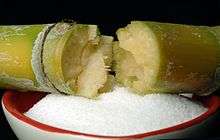Palm sugar

Palm sugar was originally made from the sap of the Palmyra palm, the date palm or the sugar date palm. Now it is also made from the sap of Arenga pinnata (sugar palm) and the nipa palm, and may therefore also be sold as "arenga sugar". Palm sugar is often labelled under various other names reflecting the several different species of palm utilised and its wide production area across Africa and Asia. Palm sugar is produced by tapping the sap from the inflorescence of the tree and boiling it down to produce a syrup, which is then sold as is, or allowed to crystallize into various shapes and sizes. In some instances the tree itself is tapped rather than the flowering spikes, but this is an isolated production method. Often the distinction is made between coconut sugar and palm sugar, but this only reflects the different species from which the sugar is sourced, i.e. coconut sugar is produced in an identical way. Thailand is one place where the distinction is made and the difference is due to palm sugar being produced there from the trunk of the tree, the sugar palm, whilst coconut sugar is tapped from the inflorescences of the coconut palm. The differences are semantic, as all the sugars under their various names are still produced from the sucrose-rich sap of a palm species.
Usage
In Thai cuisine, palm sugar is mainly used in sweets and desserts, but also in curries and sauces.
Names
- Malaysia: gula anau, gula melaka (coconut palm), gula kabung (arenga pinnata palm/sugar palm)
- Tamil Nadu: panam karkandu
- Burma: jaggery, htanye(ထန်းလျက်)
- Cambodia: skor tnot
- Telugu: nalla bellam, thaati bellam (palm jaggery)
- Kannada: Ole bella
- Kerala: panam kalkandam, Karippatti, Karipetti, Karippotti
- Bangladesh/Bengal: gur (jaggery), taal patali (solid palm sugar), khejura-cini (date palm sugar
- Indonesia: gula kelapa, gula aren, gula merah, gula semut (Gula Jawa in the Netherlands)
- Philippines: Pakaskas
- Sri Lanka: jaggery, kitul-hakuru, tal-hakuru
- Laos: nam tan pip
- Thailand: nam tan pip or nam tan puek
- Vietnam: đường thốt nốt
